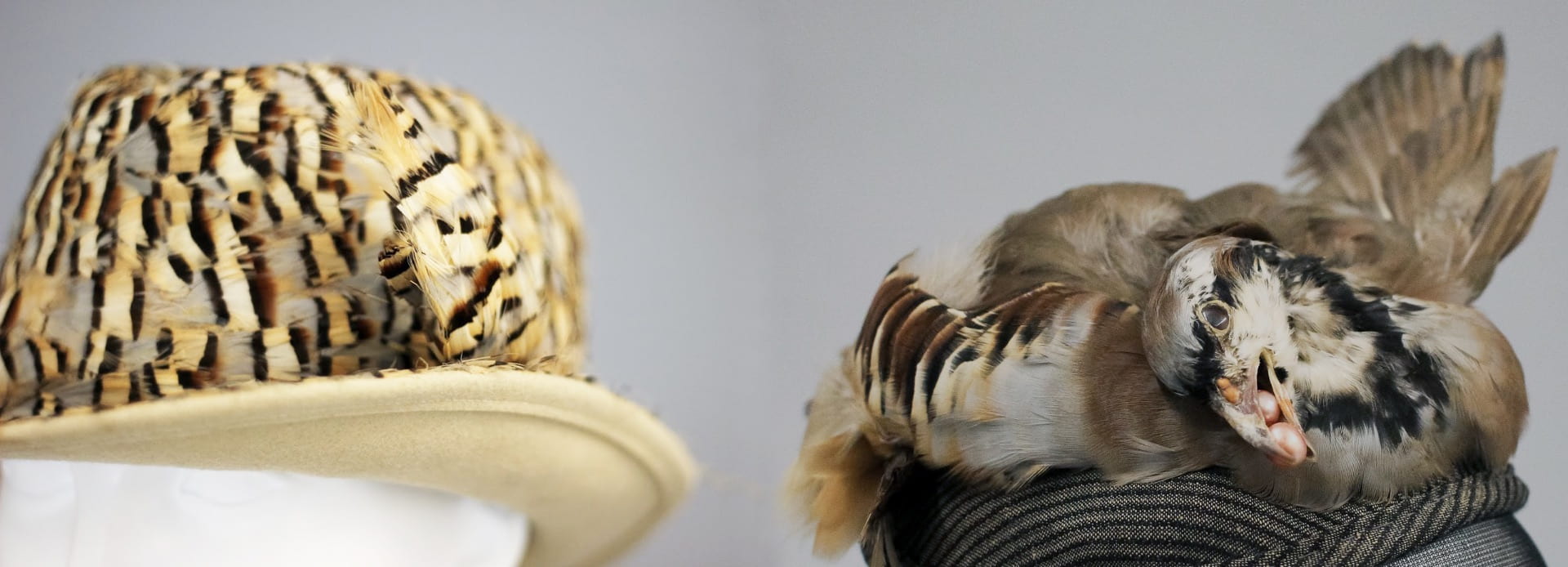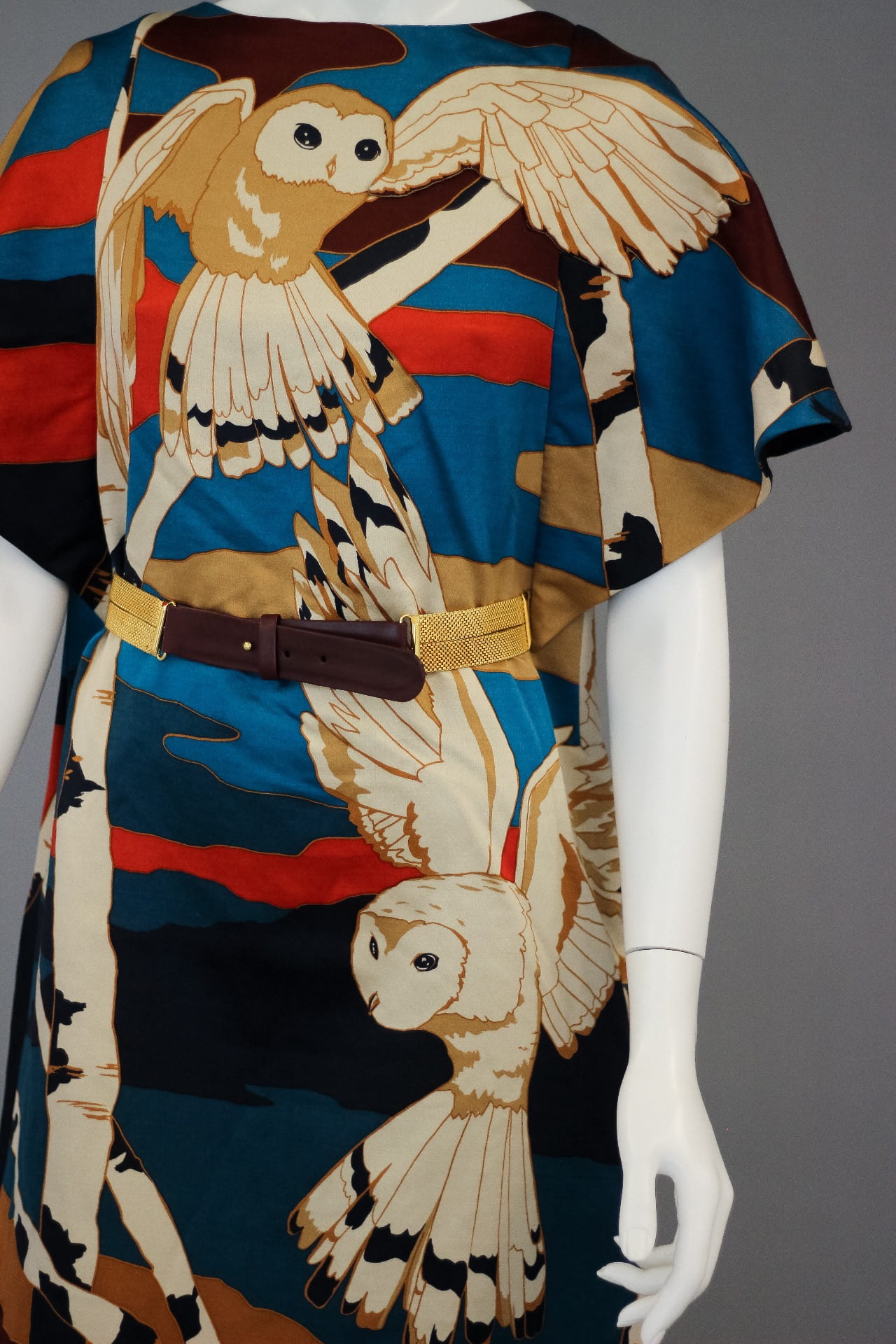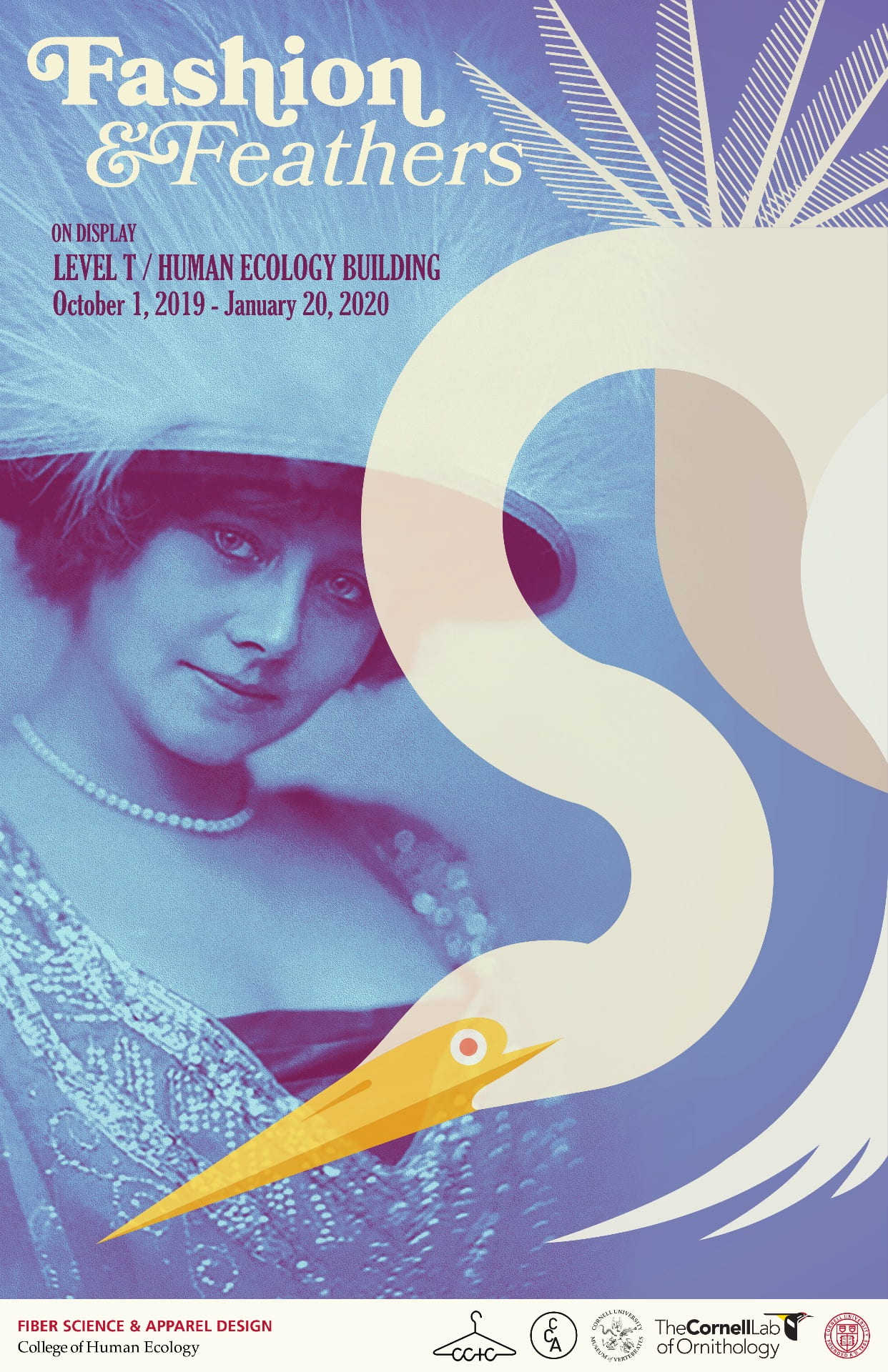FOR IMMEDIATE RELEASE
Sept. 24, 2019
Contact: costume@cornell.edu
Location: Human Ecology Building, Level T Display Cases
Hours: 8 a.m. – 8 p.m. on weekdays, 9 a.m. – 4 p.m. on weekends when Cornell University is open. Free and open to the public.
Ithaca, N.Y. – A new exhibition, Fashion & Feathers, will explore the complex and nebulous space between inspiration and exploitation by displaying fashion items alongside bird specimens, illustrations, and video footage. The exhibit will be on display October 1, 2019 – January 20, 2020, Level T of the Human Ecology Building, and is a collaboration between the Cornell Costume and Textile Collection, Cornell Lab of Ornithology, and Cornell University Museum of Vertebrates.

Left: Brooch made of tails and scalps from the now-extinct Carolina Parakeet (Conuropsis carolinensis), displayed on a late 1880s walking dress. Photo by Grace Anderson. Right: Illustration of Carolina Parakeets by John James Audubon, 1827. Originally published in “The birds of America: from original drawings,” by J. J. Audubon. Image and digitization courtesy of the Division of Rare and Manuscript Collections, Cornell University Library (identifier: h999-005_8srgb)

Advertisement for plumed hats by Bernard, October 1908. Published in Vogue, New York, Vol. 32, Issue 15 (Oct 8, 1908): 522.
Birds have long captivated fashion and textile designers: feathers come in a spectacular array of shapes, textures, and colors that are contrasted by beaks, scaly feet, and sharp talons reflecting their evolutionary past. Across the globe people have been wearing birds on their bodies—actual feathers and representations thereof—since time immemorial. Designers take inspiration from the natural world and have abstracted, stylized, and re-presented birds in fiber form; at the same time, they have also exploited birds, with some species nearly hunted to extinction for their plumes.
“Once feathers are plucked from a bird, they become more abstract because they are separated from the individual bird who has a face we can connect with,” reflects Dr. Vanya Rohwer, Curator of Birds at the Cornell University Museum of Vertebrates. “I think this dissociation makes it easier for people to wear feathers and feel distanced from the impact of the industry that brought them those same plumes.”
With increased global trade and the industrialization of European and American fashion industries in the 19th and early 20th centuries, the nature of feathers worn on the human body changed dramatically. In an industry fueled by artificial obsolescence, changing fashions for plumage (particularly within the women’s millinery industry) meant an insatiable demand for feathers. Historians estimate that by the early 20th century, 300 million birds were killed for fashion.
“Without question, the worldwide appetite for feathers in the fashion industry brought numerous bird species to near-extinction,” says Dr. John Fitzpatrick, Director of the Cornell Lab of Ornithology. “The egret-plume industry was so destructive to wild birds that it caused public outcries and the emergence of the conservation movement in North America.”

Flank feathers of a Greater Bird-of-Paradise (Paradisaea apoda) that adorns a late 19th century hat, on display in Fashion & Feathers. Photo by Grace Anderson.
“Feelings of ambivalence often characterize our relationship to fashion,” says Dr. Denise Nicole Green, Director of the Cornell Costume and Textile Collection. “We love the beauty of clothes and like to feel good in what we choose to wear. On the other hand, we are faced with wearing the tragedies that accompany production, especially within a capitalist economic system. In order to manufacture the clothes that we wear every day, human labor, natural resources, and the environment are often exploited.”

Left, a fedora style hat, circa 1945, designed by milliner Jack McConnell, and featuring distinctive patterned flank feathers of Chukar partridges (Alectoris chukar). On the right, a Chukar skin salvaged from a Pennsylvania hunter and given new life as a hat, designed by contemporary milliner-taxidermist Rachel Schlass in 2017. Photos by Grace Anderson.
Fashion & Feathers brings visibility to exploitation by including bird specimens, or “study skins,” alongside the garments and accessories featuring feathers from those same birds. These include a Victorian walking gown with a brooch made of now-extinct Carolina Parakeet (Conuropsis carolinensis) tails and scalps, an early 20th century hand muff made of the breasts of grebes, a Marabou Stork (Leptoptilos crumenifer) jacket, plumes of a Great Egret (Ardea alba), and a late 19th century hat adorned with a Greater Bird-of-Paradise (Paradisaea apoda), to name a few. The section concludes on a hopeful note by displaying a 2019 Patagonia jacket with a feather-inspired textile print and filling of 100% recycled down.

Barn owl (Tyto alba) on a Jill Stuart dress from her Fall/Winter 2011 collection. Photo by Grace Anderson.
The second half of the exhibition focuses on birds as inspiration and is organized according to the textile design technique used to portray the bird. “Identifying these birds was an act of creativity. Some are perfectly rendered in shape, size, posture, and color, and others, well, they are testaments to the ways birds can capture and fuel the imagination” says Rohwer. Highlights include elaborately embroidered Red-crowned Cranes (Grus japonensis) on a Japanese wedding kimono, Yoruba textiles dyed with a cassava root paste resist depictingHelmeted Guineafowl (Numida meleagris), a man’s house robe from the 1940s with a woven brocade wing pattern, and a lifelike printed Barn Owl (Tyto alba) that appears to be flying off the shoulder of a dress from Jill Stuart’s 2011 Fall/Winter collection.
While separate sections of the exhibition might suggest a hard line between inspiration and exploitation, the individual items on display tell a much more complex story. Inspiration is sometimes accompanied by exploitation. For example, a factory producing synthetically-dyed textiles with a design inspired by birds may be simultaneously polluting the very habitats of those same birds. On the other hand, tragedy may inspire productive change. The founding of the Audubon Society, for example, arose in direct response to the millinery industry’s sordid plume trade in the late 19th century.

Embroidered evening bag, circa 1920 – 1932, that may depict a parrot in the genus Amazona; however, because the parrot is represented on the ground it may be a Kakapo (Strigops habroptila). Photo by Grace Anderson.
Throughout Fashion & Feathers, the curators have attempted to identify as many birds as possible, hypothesizing about abstracted representations of birds and identifying actual feathers. We invite visitors to “go birding” in this exhibition. Look closely at each item, identify birds, and in doing so, reflect upon the beauty and tragedy of fashion and feathers.
Please join us for the opening reception on Tuesday, Oct. 8, 2019, 4:30 – 5:30 p.m., on Level T of the Human Ecology Building. Remarks from co-curators Denise Nicole Green, John Fitzpatrick, and Vanya Rohwer will take place at 4:45 p.m. Light refreshments provided.
Details:
Title: Fashion & Feathers
Dates: October 1, 2019 – January 20, 2020
Location: Level T, College of Human Ecology Building (37 Forest Home Dr.), Cornell University central campus, Ithaca, NY 14853
Curators: Denise Nicole Green, Ph.D. (Cornell Costume & Textile Collection), John Fitzpatrick, Ph.D. (Cornell Lab of Ornithology), and Vanya Rohwer, Ph.D. (Cornell University Museum of Vertebrates)
Funding acknowledgements: The Cornell Council for the Arts, Cornell Lab of Ornithology, and the Department of Fiber Science and Apparel Design in the College of Human Ecology at Cornell University.
Contributing Institutions: Cornell Costume and Textile Collection, Cornell Lab of Ornithology, and the Cornell University Museum of Vertebrates. Additional items on loan from private collections and the Texas Fashion Collection, University of North Texas. Illustrations courtesy of the Division of Rare and Manuscript Collections, Cornell University Library. Video footage and bird photographs courtesy of the Macaulay Library and Cornell Lab Bird Cams.
Social media: Instagram: @cornellcostumecollection @cornellbirds @cornellcouncilforthearts Facebook: @cornellcostume @cornellbirds Hashtag: #fashionandfeathers

“Talon” evening dress with jacquard design of peacock feathers. Designed by Mary Katrantzou for her Resort 2018 collection, and inspired by Baron Rothschild’s extensive nineteenth-century taxidermy collection. On loan from the Texas Fashion Collection, University of North Texas (identification: 2018.006.017)


